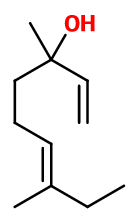
Photo credits: ScenTree SAS
| Company | Ingredient Name | ID | Comments | Naturality | Certifications | Purity | Latin name | Treated part | Geographical origin | MOQ |
|---|---|---|---|---|---|---|---|---|---|---|
|
|
Ethyllinalool | 30255405 |
Visit website
|
Molecule | - | - | - | - | - |
General Presentation
-
CAS N° : 10339-55-6
-
EINECS number : 233-732-6
-
FEMA number : Donnée indisponible.
-
FLAVIS number : Donnée indisponible.
-
JECFA number : Donnée indisponible.
-
Appearance : Colorless liquid
-
Density : 0,862
-
Volatility : Head/Heart
-
Price Range : €€€
Physico-chemical properties
-
Molecular formula : C11H20O
-
Molecular Weight : 168,28 g/mol
-
Log P : 3,3
-
Fusion Point : Donnée indisponible.
-
Boiling Point : 215°C
-
Detection Threshold : 4,2518 ng/l air
-
Optical rotation : Donnée indisponible
-
Vapor pressure : Donnée indisponible
-
Refractive Index @20°C : Donnée indisponible
-
Acid Value : Donnée indisponible.
-
Flash Point : 86°C
Uses
Uses in perfumery :
Ethyl Linalool is used in floral-fresh notes of bergamot, rose and lavender. This compound has a similar use to Linalool.
Year of discovery :
Data not available.
Natural availability :
Ethyl Linalool is not available in its natural state.
Isomerism :
Ethyl Linalool has an asymmetric carbon and a double bond capable of forming enantiomers and diastereoisomers. It is however a mixture of isomers that is used in perfumery. Aldehyde C-11 Undecylenic is a constitutional isomer of Ethyl Linalool. However, it has a much more aldehydic and less floral smell.
Regulations & IFRA
Allergens :
This ingredient does not contain any allergen.
IFRA 51th :
This ingredient is not restricted for the 51th amendment


